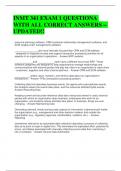INMT 341 EXAM 1 QUESTIONA
WITH ALL CORRECT ANSWERS –
UPDATED!!
resource planning) software, CRM (customer relationship management) software, and
SCM (supply chain management) software.
are more internally focused than CRM and SCM software.
- designed to integrate the data and support transaction processing activities for all
aspects of an organization's operations. - Answer-ERP systems
and each have a different focus than ERP. These
software categories are designed to help organizations manage relationships and
communications with external parties that play key roles in an organization's value chain
- customers, suppliers and other channel partners. - Answer-CRM and SCM software
collect, store, maintain, and retrieve data about an organization's
transactions. - Answer-TPSs (transaction processing system)
Collecting data that describes business events, the agents who executethose events,
the locations where the events take place, and the resources affected bythe events. -
Answer-Recording Data
Keeping current and accurate reference data about resources owned or used, external
parties with whom an organization does business, employees who work for an
organization, and locations where activities take place. In business, things are ever
changing. - Answer-Maintaining Data
Generating relevant, timely and accurate outputs for information customers both inside
the organization (e.g., management and other decision makers) and outside the
organization (e.g., regulatory agencies, stockholders, creditors, etc.). - Answer-
Reporting
(sometimes referred to as automated data collection) describes a process of collecting
data at its point of origin in digital form. This eliminates the duplicated effort, potential for
errors, and delays associated with manually collecting source data then reentering it
into a computer. - Answer-Source Data Automation
,understood by both the sending computer and the receiving computer. - Answer-EDI
(Electronic Data Interchange)
- Data does not just flow within an organization, but needs to flow between
organizations. To enhance the efficiency of the purchaser/supplier relationship, many
companies require or encourage the use of EDI
What are two standards for EDI: - Answer-•ANSI X12 was developed by the American
National Standards Institute and is used for North America transaction sets.
•EDIFACT8 was developed by the United Nations Economic commission. Outside of
North America, it is the most widely used standard.
The data are stored in a , which is another term for a collection
of data such as a database, a file, or a data warehouse. This data repository is used to
generate information outputs. - Answer-data repository
What are the 5 types of data files used in business transaction processing systems? -
Answer-master files, transaction files, history files, reference files, and suspense files.
Master files - Answer-Contain balance data or the status of an entity at a point in time.
Examples include inventory files, customer files, employee files, vendor files, or cash
account files.
Master files do not contain event or activity data (meaning that do not contain the details
about the transactions that change their balances).
Files that contain business activity data (i.e., transaction data used to update balances
in master files) are referred to as .
Examples include order files, billing files, shipping files, and cash receipt files.
In automated systems, these files are electronic.
In manual systems, batches of paper source documents that document transaction data
are examples of these files. - Answer-Transaction files.
Contain inactive past or historical data. Examples could include tax return files from
previous years or human resource files of employees who are no longer with the
organization. - Answer-History files (which may be called archive files)
referential data such as a tax rate schedule, a volume pricing list, or a listing of the
general ledger chart of accounts. - Answer-Reference files contain
contain data awaiting some action to complete their processing. Examples include
customer payments waiting to be deposited or records identified as incomplete or
, erroneous that need correction and reentry to complete processing. - Answer-Suspense
files
Processing is often identified by type: - Answer-batch or real time processing (via online
devices). Batch processing can occur in either manual or automated systems.
Batch processing accumulates transaction data for a period of time to collect a group
(called a batch) of transaction data before proceeding with processing. Then the batch
of transactions is posted to the master file in one processing run.
are not associated with manual systems and are connected
to a CPU(a computer's processor or 'brain'). Online devices facilitatereal time
processing. - Answer-Online devices
include recording incomplete, inaccurate, or invalid data about a business event
(transaction data). Incomplete data results in not recording all of the relevant
characteristics about a business event in the data stores. Inaccurate data arises from
recording data that does not accurately represent the event. Invalid data refers to data
that are recorded about a fabricated event. - Answer-Recording risks - Recording risks
Maintaining risks - Answer-are similar to recording risks but focuses on master and
reference data. Instead of referring to the risks of recording event data, maintaining
risks refer to the risks of initially recording, then keeping current, the data stored about
organizational resources, agents, and locations.
involve data outputs. They include distributing data that are inaccurate, improperly
classified, improperly summarized, provided to unauthorized parties, and/or not
provided in a timely manner. - Answer-Reporting risks - Reporting risks
Successful organizations strive to limit these information risks and also leverage
information technology to help reduce the - Answer-business risks we discussed during
business process analysis.
The math professor who originally proposed the idea of artificial intelligence explained
AI as .
•voice recognition, like Amazon Echo or Siri on an iPhone,
•cars (like Tesla) that can drive or predict future driving actions,
•the Cogito application that improves the emotional intelligence of customer support
representatives,
•Google's Nest learning thermostat which can be voice-controlled by Alexa, and
•various applications that can predict or anticipate needs from shopping
(Amazon.com),entertaining viewing (Netflix), music (Pandora), to travel and concierge
service needs (Box ever and John Paul). - Answer-"every aspect of learning or any
other feature of intelligence can in principle be so precisely described that a machine
can be made to simulate it."




